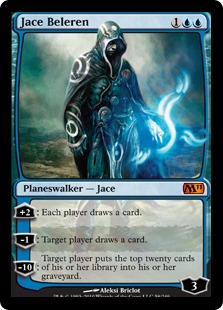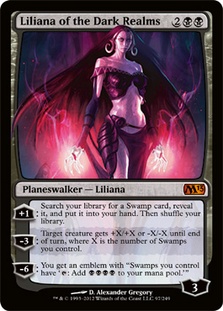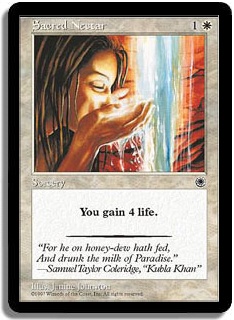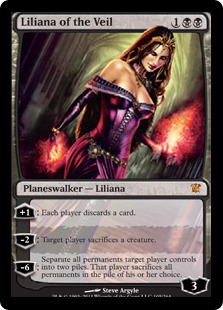“That which has been is that which will be,
And that which has been done is that which will be done.
So there is nothing new under the sun.”
— Ecclesiastes 1:9 (New American Standard Bible)
As with the other parts of Wizards of the Coast R&D, Creative walks the proverbial chain in a gore-house with every decision made for Magic. Too little of the familiar and customers leave because they don’t understand what the game is trying to do; too much of the familiar and customers leave because they’ve seen it all before. Magic’s preferred path is to put a new “Magic spin” on archetypes, the overarching ideas and stories that pervade a culture.
Sometimes this involves banishing a certain archetype altogether. The woman on Soulgorger Orgg, for example, is as close as Magic usually gets to the damsel in distress. In Magic: The Gathering, sexy while appearing powerful is ok. Sexy while appearing weak, submissive, or “getting choke-slammed against a huge rock by a burly dude raising his fist” is not.
Context matters, but every card also must stand on its own.
Liliana, the planeswalker pictured on Triumph of Ferocity and many other Magic cards, draws on many archetypes that influence her personality. At times, these archetypes collapse into stereotypes despite the best intentions of Wizards Creative. Today I’ll explore three of those dimensions in greater detail: the Faustian bargainer who makes a deal with the devil, the seemingly troubled noir femme fatale, and the harem dweller of popular Western imagination.
Faust: Liliana, Dealer with Demons
The notion of a “deal with a devil,” or bargaining one’s soul to a dark or evil force in exchange for temporary power, has been part of world culture for millennia. Its pervasiveness is such that the trope has its own “in popular culture” Wikipedia page. The iconic dealer with devils is Faust, whose legend spawned multiple works of literature in the Western canon, but the idea has filtered down to The Twilight Zone, The Simpsons, country music, and many other works.
In Liliana’s case, she made a deal with multiple demons—four of them—to restore the youth and beauty she had lost to time. Almost every “deal with the devil” story features the recipient of the devil’s riches trying to renege on the other part of the transaction, usually by seeking loopholes. The dealer’s success varies; Faust and the protagonist of the Twilight Zone episode do not escape and are damned, while Homer Simpson slips through a loophole and Johnny in “The Devil Went Down to Georgia” bulldozes through the devil’s rigged contest.
Liliana’s distinctive spin on the Faustian bargain is that she’s trying to get out of hers by annihilating the same demons who would lay claim to her soul. With two demons down and two to go, she is on her way to victory, but that part of her story is far from over. For those of us outside the walls of Wizards, it remains to be seen whether Liliana’s attempt to cheat her deal ends in success or failure. In the meantime, for putting a new twist on the Faust archetype, this dimension of Liliana gets my Vorthos seal of approval.
Noir: Liliana, Femme Fatale
The femme fatale in 20th and 21st century culture is the “magically depowered” version of the seductive enchantress, and though Liliana has more in common with mythological seductresses such as Circe and Calypso than the breathless beauties who impose on hardboiled private eyes, the latter are more familiar today.
The visuals of film noir, hardboiled crime comics, and related forms of entertainment do not always include femmes fatale, but many of the best examples of their genre do. Filmmakers and comics inkers figured out long ago that for the too often assumed default audience of heterosexual men (and reigning blue planeswalker Jace), other folks’ problems are more interesting when they’re attached to dangerous, attractive women.
“Tell me more.”
The femmes fatale of noir have several characteristics in common. They use whatever emotional charms they can—usually a combination of the damsel in distress and the temptress—to manipulate others into doing their bidding, never doing the “dirty work” themselves unless they must. In the Planeswalker Novel Agents of Artifice, Liliana is by turns Jace’s lover and betrayer, a familiar pattern from hardboiled entertainment where detectives get hired, seduced, and left for dead. One can only imagine how badly life went downhill for Innistrad’s mad necromancer Geralf when he “found” Liliana hanging around Thraben Cathedral.
The femme fatale aspects of Liliana’s persona are both liberating and problematic. Distant predecessors such as John the Baptist-condemning dancer Salome were both warnings against the “dangers” of a woman’s sexuality and indulgences in the same; the hypocrisy of a man leering as he lectures, “Look how Salome tempts Herod with her Dance of the Seven Veils,” should be plain. The mysterious beauty of noir fiction may be all but innocent or guilty as sin, but either way she exists to charm and ensnare the (again, assumed heterosexual male) audience as surely as the private eyes on page and screen. In fiction the femme fatale uses men, but in the outer world the creator uses her.
Who is Liliana, Femme Fatale? User of Jace and Geralf? Pawn of Nicol Bolas and the Raven Man? Tool of Wizards in the branch of its marketing that boils down to “This is a game for smart people. P.S. It has boobies!”? In each case, the answer is “Yes.”
Orientalism: Liliana, Harem Girl
The opera-fueled figure of a seductive Salome ties into a third aspect of Liliana that doubtless started with good intentions but quickly spiraled into unfortunate implications. On his Tumblr page, Mark Rosewater answered a question about diversity among Magic’s planeswalkers by singling out Liliana’s ethnicity as “Middle Eastern.” Multiple writers responded, in effect, “So you gave the ‘Middle Eastern’ planeswalker a veil? Not cool.”
Why is the characterization of Liliana as “Middle Eastern” troubling? It plays into a longstanding and unfortunate trope of Western European and related attitudes called orientalism.* The recipe is fairly simple: take an Asian (anywhere from Turkey to Vietnam will do) culture that’s not yours, appropriate** some stuff that seems outlandish, make some more stuff up, and sell it all back to your own culture as “exotic.” The persistent redefinition of a culture seen as the “other” is how a harem, originally the decidedly unsexy women’s quarters in a household, became in the broader Western imagination a private bordello.
Orientalist art of past generations includes overtly erotic paintings of odalisques and sculptures such as the infamous Hiram Powers nude The Greek Slave. Orientalist influence in literature ranges from Samuel Taylor Coleridge’s fantastically fictional poem “Kubla Khan” (quoted on Sacred Nectar) to George MacDonald Fraser’s more historically grounded but plenty prurient Flashman series, about a fictional Victorian-era English army officer who sleeps his way around the world. A notable early film with orientalist overtones is The Thief of Bagdad. More recent screen manifestations of orientalism include the Disneyfied version in Aladdin and the Dothraki as filmed for HBO’s George R.R. Martin adaptation, Game of Thrones.
All this is to say that orientalism and its derivatives have seeped in almost everywhere in Western culture…even Magic cards.
Of course, if you’re from one of those cultures defined as “other” by orientalism, the whole trend is misrepresentative at best and exploitative most of the time. Wizards didn’t set out to offend when making Liliana—ticking off potential customers is bad for business. The line between populating a fictional world with diverse characters and doing so with stereotypes can be blurry, however, and Wizards’ “Middle Eastern” planeswalker ended up as a necromantic almost-odalisque with a veil as her most powerful weapon. This orientalist-influenced aspect of Liliana could use a cultural makeover.
Planeswalker Liliana: Archetype or Stereotype?
Had Liliana been left ambiguous in her ethnic background, she wouldn’t be nearly so problematic a character as she is. The deal with the devil is an ancient trope, and Liliana puts an enjoyable spin on it. Femmes fatale are staples of fiction and have been used badly in the past, but as a representative of the trope she is far more active than usual—devious and manipulative, but at the same time a more positive representation than the typical spurt of victimhood.
Liliana as “Middle Eastern,” however, was a bit of insider trivia that should’ve been kept in-house. It doesn’t add anything to her character, but revealing it caused me and others to reevaluate the character and her attributes such as the Chain Veil took on new and potentially offensive meanings. There’s no good way to take back the identification of Liliana’s ethnicity, but her character gradually could be moved away from the more questionable trappings. (For example, the Chain Veil is powerful but seemingly dangerous to Liliana, chipping away at her sanity; self-preservation may force her to destroy it to save herself.)
Wizards does a great job, all things considered, of creating a diverse and enjoyable game. With the planeswalker Liliana, they had a slight bobble. My hope is that the company learns from the experience and carries on with delivering interesting and nuanced characters year after year.
As always, thanks for reading.
— JDB
@jdbeety on Twitter
* The orientalist harem girl arguably is not the most offensive “Middle Eastern” stereotype that could be leveled against Liliana. Her storyline in “Angel’s Rise and Demon’s Release“—minus the part with Griselbrand—includes mass killing, hostage taking, and blowing up a monument.
** Another example of cultural appropriation embedded in Magic: “mana” originally was a Pacific Islander concept before it was adapted into Western gaming culture.





